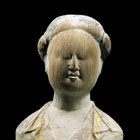J.J. Lally & Co., Oriental Art / New York City, New York
MenuPast Exhibition
Ancient Chinese Tomb Sculpture
March 22 - April 10, 2004
16.
A PAINTED AND GILDED WOOD FIGURE OF A YOUNG MAN
Tang Dynasty, A.D. 7th Century
shown standing in a respectful pose with hands clasped in front of his chest, wearing a long tunic with wide crossed-over lapels and long sleeves, tied at the waist with a narrow black-painted belt with the end tucked in at his back, his tunic showing extensive remains of red and bright green pigments, with gold leaf and traces of red lines on his lapels, and with further gilding along the edges of the split seams where his tunic opens at either side, his trousers with remains of black pigment, his head turned to one side with his hair neatly gathered in a wide roll, his face with small features and a calm expression.
Height 17 3⁄4 inches (45.1 cm)
A more deteriorated and fragmentary Tang dynasty wood figure with similar head and the same distinctive arrangement of the hair is in the musée Cernuschi, Paris, donated by M. Jacques Barrère, and is illustrated by Marie-Therese Bobot in Chine connue & inconnue, Paris, 1992, pp. 140-141, together with the Tang dynasty wood head and torso of a horse.
Several fragments of painted wood tomb figures including the heads of male and female figures in court dress, the head of a Central Asian, the legs of horses, and the head and torso of a lokapala, all discovered in 1985 in Tang dynasty tombs at Yanchi in Ningxia province, northwestern China, are illustrated in an excavation report in Wenwu, 1988, No. 9, pp. 43-56.
A pair of wood figures of female attendants in the William Rockhill Nelson Gallery of Art – Atkins Museum of Fine Arts, Kansas City, exhibited at the Portland Art Museum in 1976, are illustrated by Donald Jenkins in the catalogue entitled Masterworks in Wood: China and Japan, Portland Art Museum, 1976, pp. 28-29, no. 8, dated to the Sui dynasty, circa A.D. 600.
A simple carved wood figure of a courtesan of the so-called ‘fat lady’ type, with traces of painted decoration in black and colors, excavated from a Tang site in Qinghai is illustrated in A Selection of the Treasure of Archeological Finds of the People’s Republic of China 1976-1984, Beijing, 1987, no. 376.
Compare also the three Tang dynasty painted wood figures shown in the Kaohsiung Museum of Fine Arts and illustrated in the catalogue entitled Ancient Chinese Sculptural Treasures: Carvings in Wood, Kaohsiung, Taiwan, 1998, cat. nos. 38-40.
